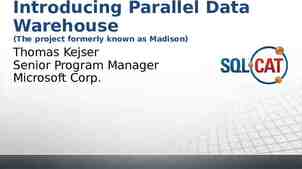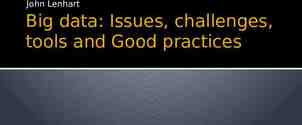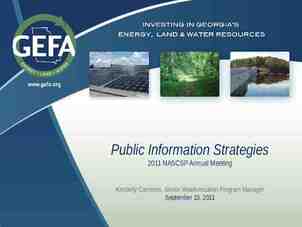ECE 683 Computer Network Design & Analysis Note 3:
90 Slides1.38 MB

ECE 683 Computer Network Design & Analysis Note 3: Digital Transmission Fundamentals 1

Outline Overview of physical layer Digital representation of Information Why digital transmission? Line coding Modulation/demodulation Properties of transmission media 2

Introduction 3

Physical layer 4

What You Need for Better Understanding 5

Source Coding Networks are handling streams of 0’s and 1’ Source Encoding: compression, according to statistics of 0’s and 1’s, map blocks of bits to more regular “shorter” blocks! Get rid of redundancy Source Decoding: inverse of source encoding 6

Channel Coding Channel Encoding: According to channel conditions, add redundancy for more reliable transmission Channel decoding: the inverse Observation: source encoding attempts to eliminate “useless information”, while channel encoding add “useful information”; both deal with redundancies! 7

Modulation/Demodulation Modulation: maps blocks of bits to well-defined waveforms or symbols (a set of signals for better transmission), then shifts transmission to the carrier frequency band (the band you have right to transmit) Demodulation: the inverse of modulation Demodulation vs. Detection: Detection is to recover the modulated signal from the “distorted noisy” received signals 8

Physical Components Transmitter Receiver Transmission media – Guided: cable, twisted pair, fiber – Unguided: wireless (radio, infrared) 9

Information Carriers s(t) A sin (2 ft ) * Amplitude: A * Frequency: f --- f 1/T, T---period * Phase: , angle (2 ft ) 10

Signal Types Basic form: A signal is a time function Continuous signal: varying continuously with time, e.g., speech Discrete signal: varying at discrete time instants Periodic signal: Pattern repeated over time Aperiodic signal: Pattern not repeated over time, e.g., speech 11

Continuous & Discrete Signals Amplitude (volts) time (a) Continuous Amplitude (volts) time (b) Discrete 12

Periodic Signals 13

Varying Sine Waves 14

Frequency Domain Concept Signal is usually made up of many frequencies Components are sine waves Can be shown (Fourier analysis) that any signal is made up of component sine waves Can plot frequency domain functions Time domain representation is equivalent to frequency domain representation: they contain the same information! Frequency domain representation is easier for design 15

Fourier Representation n 16

Addition of Signals 17

Received Signals Any receiver can only receive signals in a certain frequency range, corresponding to a finite number of terms in the Fourier series approximation: – physically: a finite number of harmonics – mathematically: a finite number of terms Transmitted signal design: allocate as many terms as possible in the intended receiver’s receiving range (most power is contained in the intended receiving frequency band) 18

Signal Spectrum & Bandwidth Spectrum: the range of frequencies contained in a signal Absolute bandwidth: width of spectrum or the frequency range in which the signal’s Fourier transform is non-zero Effective bandwidth: just called BW (BandWidth), Narrow band of frequencies containing most of the energy – 3 dB BW – Percentage BW: percentage power in the frequency band DC Component: Frequency component of zero frequency (i.e., constant) 19

Signal Bandwidth Illustration Bandwidth of a signal is a measure of how fast its parameters (e.g., amplitude or phase) change with time 20

Note 3: Digital Transmission Fundamentals Digital Representation of Information 21

Bits, numbers, information Bit: number with value 0 or 1 – n bits: digital representation for 0, 1, , 2n – Byte or Octet, n 8 – Computer word, n 16, 32, or 64 n bits allows enumeration of 2n possibilities – n-bit field in a header – n-bit representation of a voice sample – Message consisting of n bits The number of bits required to represent a message is a measure of its information content – More bits More content 22

Block vs. Stream Information Block Information that occurs in a single block – – – – Text message Data file JPEG image MPEG file Size Bits / block or bytes/block – 1 kbyte 210 bytes – 1 Mbyte 220 bytes – 1 Gbyte 230 bytes Stream Information that is produced & transmitted continuously – Real-time voice – Streaming video Bit rate bits / second – 1 kbps 103 bps – 1 Mbps 106 bps – 1 Gbps 109 bps 23

Transmission Delay L number of bits in message R bps speed of digital transmission system L/R time to transmit the information tprop d c time for signal to propagate across medium distance in meters speed of light (3x108 m/s in vacuum) Delay tprop L/R d/c L/R seconds Use data compression to reduce L Use higher-speed modem to increase R Place receiver closer to reduce d 24

Compression Information usually not represented efficiently Data compression algorithms – Represent the information using fewer bits – Lossless: original information recovered exactly E.g. zip, rar, compress, GIF, fax – Lossy: recover information approximately JPEG Tradeoff: # bits vs. quality Compression Ratio #bits (original file) / #bits (compressed file) 25

Color Image W H Color image H W W W Red component image Green component image Blue component image H H Total bits 3 H W pixels B bits/pixel 3HWB bits Example: 8 10 inch picture at 400 400 pixels per inch2 400 400 8 10 12.8 million pixels 8 bits/pixel/color 12.8 megapixels 3 bytes/pixel 38.4 megabytes 26

Examples of Block Information Type Method Format Original Compressed (Ratio) Text Zip, compress ASCII KbytesMbytes (2-6) Fax CCITT Group 3 A4 page 200x100 pixels/in2 256 kbytes 5-54 kbytes (5-50) JPEG 8x10 in2 photo 4002 pixels/in2 38.4 Mbytes 1-8 Mbytes (5-30) Color Image 27

Stream Information A real-time voice signal must be digitized & transmitted as it is produced Analog signal level varies continuously in time Th e s p ee ch s i g n al l e v el v a r ie s w i th t i m(e) 28

Digitization of Analog Signal Sample analog signal in time and amplitude Find closest approximation Original signal 3 bits / sample Sample value Approximation Rs Bit rate # bits/sample x # samples/second 29

Bit Rate of Digitized Signal Bandwidth Ws Hertz: how fast the signal changes – Higher bandwidth more frequent samples – Minimum sampling rate 2 x Ws (the Nyquist rate) Representation accuracy: range of approximation error – Higher accuracy smaller spacing between approximation values more bits per sample 30

Example: Voice & Audio Telephone voice Ws 4 kHz 8000 samples/sec 8 bits/sample Rs 8 x 8000 64 kbps Cellular phones use more powerful compression algorithms: 8-12 kbps CD Audio Ws 22 kHertz 44000 samples/sec 16 bits/sample Rs 16 x 44000 704 kbps per audio channel MP3 uses more powerful compression algorithms: 50 kbps per audio channel 31

Video Signal Sequence of picture frames – Each picture digitized & compressed Frame repetition rate – 10-30-60 frames/second depending on quality Frame resolution – Small frames for videoconferencing – Standard frames for conventional broadcast TV – HDTV frames 30 fps Rate M bits/pixel x (WxH) pixels/frame x F frames/second 32

Video Frames 176 QCIF videoconferencing at 30 frames/sec 144 760,000 pixels/sec 720 Broadcast TV 480 at 30 frames/sec 10.4 x 106 pixels/sec 1920 HDTV at 30 frames/sec 1080 67 x 106 pixels/sec 33

Digital Video Signals Type Method Format Original Compressed Video Conference H.261 2-36 Mbps 64-1544 kbps Full Motion MPEG2 176x144 or 352x288 pix @10-30 fr/sec 720x480 pix @30 fr/sec 249 Mbps 2-6 Mbps HDTV MPEG2 1920x1080 @30 fr/sec 1.6 Gbps 19-38 Mbps 34

Transmission of Stream Information Constant bit-rate (CBR) – Signals such as digitized telephone voice produce a steady stream: e.g. 64 kbps – Network must support steady transfer of signal, e.g. 64 kbps circuit Variable bit-rate (VBR) – Signals such as digitized video produce a stream that varies in bit rate, e.g., according to motion and detail in a scene – Network must support variable transfer rate of signal, e.g., packet switching or rate-smoothing with constant bit-rate circuit 35

Stream Service Quality Issues Network Transmission Impairments Delay: Is information delivered in timely fashion? Jitter: Is information delivered in sufficiently smooth fashion? Loss: Is information delivered without loss? If loss occurs, is delivered signal quality acceptable? Applications & application layer protocols developed to deal with these impairments 36

Note 3: Digital Transmission Fundamentals Why Digital Transmission? 37

A Transmission System Transmitter Receiver Communication channel Transmitter Converts information into signal suitable for transmission Injects energy into communication medium or channel – Telephone converts voice into electric current – Modem converts bits into tones Receiver Receives energy from medium Converts received signal into a form suitable for delivery to users – Telephone converts current into voice – Modem converts tones into bits 38

Analog vs. Digital Transmission Analog transmission: all details must be reproduced accurately Sent Distortion Attenuation Received Digital transmission: only discrete levels need to be reproduced Sent Distortion Attenuation Received Simple Receiver: Was original pulse positive or negative? 39

Transmission Impairments Transmitter Transmitted Signal Received Signal Receiver Communication channel Communication Channel Pair of copper wires Coaxial cable Radio Light in optical fiber Light in air Infrared Transmission Impairments Signal attenuation Signal distortion Spurious noise Interference from other signals 40

Analog Long-Distance Communications Transmission segment Source Repeater . Repeater Destination Each repeater attempts to restore analog signal to its original form Restoration is imperfect – Distortion is not completely eliminated – Noise & interference are only partially removed Signal quality decreases with # of repeaters Communication is distance-limited Still used in analog cable TV systems Analogy: Copy a song using a cassette recorder 41

An Analog Repeater 42

Digital Long-Distance Communications Transmission segment Source Regenerator . Regenerator Destination Regenerator recovers original data sequence and retransmits on the next segment Can design so such that the error probability is very small Then each regeneration is like the first time! Analogy: copy an MP3 file Communication is possible over very long distances 43

A Digital Regenerator 44

Advantages of Digital over Analog Digital regenerators eliminate the accumulation of noise that takes place in analog systems – It is thus possible to provide long-distance transmission that is nearly independent of distance Digital transmission systems can operate with lower signal levels or with greater distances between regenerators – This translates into lower overall system cost Digital transmission facilitates the monitoring of the quality of a transmission channel in service – Nonintrusive monitoring is much more difficult in analog transmission systems Digital transmission systems can multiplex and switch any type of information represented in a digital form Digital transmission also allows networks to exploit the advances in digital computer technology – Error correction, data encryption, various types of network protocols 45

Digital Binary Signal 1 A 0 0 T 1 2T 1 3T 0 4T 5T 1 6T -A Bit rate 1 bit / T seconds For a given communication medium: How do we increase transmission speed? How do we achieve reliable communications? Are there limits to speed and reliability? 46

Pulse Transmission Rate Objective: Maximize pulse rate through a channel, that is, make T as small as possible Channel T t t If input is a narrow pulse, then typical output is a spread-out pulse with ringing Question: How frequently can these pulses be transmitted without interfering with each other? Answer: 2 x Wc pulses/second (Nyquist rate), where Wc is the bandwidth of the channel 47

Bandwidth of a Channel X(t) a cos(2 ft) Channel Y(t) A(f) a cos(2 ft) If input is sinusoid of frequency f, then – output is a sinusoid of same frequency f – Output is attenuated by an amount A(f) that depends on f – A(f) 1, then input signal passes readily – A(f) 0, then input signal is blocked Bandwidth Wc is range of frequencies passed by channel A(f) 1 0 f Wc Ideal low-pass channel 48

Multilevel Pulse Transmission Assume a channel of bandwidth Wc, and transmit 2 Wc pulses/sec (without interference) If pulses amplitudes are either -A or A, then each pulse conveys 1 bit, so Bit Rate 1 bit/pulse x 2Wc pulses/sec 2Wc bps If amplitudes are from {-A, -A/3, A/3, A}, then bit rate is 2 x 2Wc bps By going to M 2m amplitude levels, we achieve Bit Rate m bits/pulse x 2Wc pulses/sec 2mWc bps In the absence of noise, the bit rate can be increased without limit by increasing m 49

Noise & Reliable Communications All physical systems have noise – Electrons always vibrate at non-zero temperature – Motion of electrons induces noise Presence of noise limits accuracy of measurement of received signal amplitude Errors occur if signal separation is comparable to noise level Bit Error Rate (BER) increases with decreasing signal-tonoise ratio Noise places a limit on how many amplitude levels can be used in pulse transmission 50

Signal-to-Noise Ratio Signal Signal noise Noise High SNR t t t No errors Noise Signal Signal noise Low SNR t SNR t t Average signal power error Average noise power SNR (dB) 10 log10 SNR 51

Shannon Channel Capacity C Wc log2 (1 SNR) bps Arbitrarily reliable communication is possible if the transmission rate R C. If R C, then arbitrarily reliable communication is not possible. “Arbitrarily reliable” means the BER can be made arbitrarily small through sufficiently complex coding. C can be used as a measure of how close a system design is to the best achievable performance. Bandwidth Wc & SNR determine C 52

Example Find the Shannon channel capacity for a telephone channel with Wc 3400 Hz and SNR 10000 C 3400 log2 (1 10000) 3400 log10 (10001)/log102 45200 bps Note 1: SNR 10000 corresponds to SNR (dB) 10 log10(10000) 40 dB Note 2: log102 You are required to find C given Wc in proper unit, e.g., Hz, kHz, and MHz, and SNR in dB. 53

Bit Rates of Digital Transmission Systems System Bit Rate Observations Telephone twisted pair 33.6-56 kbps 4 kHz telephone channel Ethernet twisted pair 10 Mbps, 100 Mbps 100 meters of unshielded twisted copper wire pair Cable modem 500 kbps-4 Mbps Shared CATV return channel ADSL twisted pair 64-640 kbps in, 1.5366.144 Mbps out Coexists with analog telephone signal 2.4 GHz radio 2-11 Mbps IEEE 802.11 wireless LAN 28 GHz radio 1.5-45 Mbps 5 km multipoint radio Optical fiber 2.5-10 Gbps 1 wavelength Optical fiber 1600 Gbps Many wavelengths 54

Examples of Channels Channel Bandwidth Bit Rates Telephone voice channel 3 kHz 33 kbps Copper pair 1 MHz 1-6 Mbps 500 MHz (6 MHz channels) 300 MHz (11 channels) Many TeraHertz 30 Mbps/ channel Coaxial cable 5 GHz radio (IEEE 802.11) Optical fiber 54 Mbps / channel 40 Gbps / wavelength 55

Note 3: Digital Transmission Fundamentals Line Coding 56

Source vs. Channel vs. Line Coding Source coding: eliminating redundancy in order to make efficient use of storage space and/or transmission channels – Huffman coding/ Morse code Channel coding: a pre-transmission mapping applied to a digital signal or file, usually designed to make errorcorrection possible – Parity check / Hamming code / Reed-Soloman code Line coding: performed to adapt the transmitted signal to the (electrical) characteristics of a transmission channel Order: source coding - channel coding - line coding 57

What is Line Coding? Mapping of binary information sequence into the digital signal that enters the channel – Ex. “1” maps to A square pulse; “0” to –A pulse Line code selected to meet system requirements: – – – – Transmitted power: Power consumption Bit timing: Transitions in signal help timing recovery Bandwidth efficiency: Excessive transitions wastes bw Low frequency content: Some channels block low frequencies long periods of A or of –A causes signal to “droop” Waveform should not have low-frequency content – Error detection: Ability to detect errors helps – Complexity/cost: Is code implementable in chip at high speed? 58

Line coding examples 1 Unipolar NRZ 0 1 0 1 1 1 0 0 NRZ Non-Return-to-Zero Polar NRZ NRZ-inverted (differential encoding) Bipolar encoding Manchester encoding Differential Manchester encoding 59

Spectrum of Line codes Assume 1s & 0s independent & equiprobable NRZ has high content at low frequencies Bipolar tightly packed around f 1/(2T) or 0.5/T Manchester wasteful of bandwidth 1.2 NRZ 1 Bipolar 0.6 0.4 Manchester 0.2 2 1.8 1.6 1.4 1.2 1 0.8 0.6 0.4 -0.2 0.2 0 0 pow er density 0.8 fT 60

Unipolar & Polar Non-Return-to-Zero (NRZ) 1 0 1 0 1 1 1 0 0 Unipolar NRZ Polar NRZ Unipolar NRZ Polar NRZ “1” maps to A pulse “0” maps to no pulse High Average Power 0.5*A2 0.5*02 A2/2 Long strings of A or 0 – Poor timing – Low-frequency content Simple “1” maps to A/2 pulse “0” maps to –A/2 pulse Better Average Power 0.5*(A/2)2 0.5*(-A/2)2 A2/4 Long strings of A/2 or –A/2 – Poor timing – Low-frequency content Simple 61

Bipolar Code 1 0 1 0 1 1 1 0 0 Bipolar Encoding Three signal levels: {-A, 0, A} “1” maps to A or –A in alternation “0” maps to no pulse – Every pulse matched by –pulse so little content at low frequencies String of 1s produces a square wave – Spectrum centered at around f 1/(2T) or 0.5/T Long string of 0s causes receiver to lose synchronization Zero-substitution codes are needed 62

Manchester code & mBnB codes 1 0 1 0 1 1 1 0 0 Manchester Encoding “1” maps into A/2 first T/2, -A/2 last T/2 “0” maps into -A/2 first T/2, A/2 last T/2 Every interval has transition in middle – Timing recovery easy – Uses double the minimum bandwidth Simple to implement Used in 10-Mbps Ethernet & other LAN standards mBnB line code Maps block of m bits into n bits Manchester code is 1B2B code 4B5B code used in FDDI LAN 8B10b code used in Gigabit Ethernet 64B66B code used in 10G Ethernet 63

Differential Coding 1 0 1 0 1 1 1 0 0 NRZ-inverted (differential encoding) Differential Manchester encoding Errors in some systems cause transposition in polarity, A become –A and vice versa – All subsequent bits in Polar NRZ coding would be in error Differential line coding provides robustness to this type of error “1” mapped into transition in signal level “0” mapped into no transition in signal level Also used along with Manchester coding 64

Note 3: Digital Transmission Fundamentals Modulation/Demodulation 65

Bandpass Channels 0 fc – Wc/2 fc fc Wc/2 Bandpass channels pass a range of frequencies around some center frequency fc – Radio channels, telephone & DSL modems Digital modulators embed information into waveform with frequencies passed by bandpass channel Sinusoid of frequency fc is centered in middle of bandpass channel Modulators embed information into a sinusoid 66

Amplitude Modulation and Frequency Modulation Information 1 0 1 1 0 1 1 Amplitude Shift Keying 0 T 2T 3T 4T 5T 6T t -1 Map bits into amplitude of sinusoid: “1” send sinusoid; “0” no sinusoid Demodulator looks for signal vs. no signal 1 Frequency Shift Keying 0 T 2T 3T 4T 5T 6T t -1 Map bits into frequency: “1” send frequency fc ; “0” send frequency fc - Demodulator looks for power around fc or fc - 67

Phase Modulation Information Phase Shift Keying 1 0 1 1 0 1 1 0 2T T 3T 4T 5T 6T t -1 Map bits into phase of sinusoid: – “1” send A cos(2 ft) – “0” send A cos(2 ft ) , i.e. phase is 0 , i.e. phase is Equivalent to multiplying cos(2 ft) by A or -A – “1” send A cos(2 ft) , i.e. multiply by 1 – “0” send A cos(2 ft ) - A cos(2 ft) , i.e. multiply by -1 We will focus on phase modulation 68

Modulator & Demodulator Modulate cos(2 fct) by multiplying by Ak for T seconds: x Ak Yi(t) Ak cos(2 fct) cos(2 fct) Transmitted signal during kth interval Demodulate (recover Ak) by multiplying by 2cos(2 fct) for T seconds and lowpass filtering (smoothing): Yi(t) Akcos(2 fct) Received signal during kth interval x 2cos(2 fct) Lowpass Filter (Smoother) Xi(t) 2Ak cos2(2 fct) Ak {1 cos(2 2fct)} 69

Example of Modulation 1 Information Baseband Signal 1 1 0 1 A -A Modulated Signal x(t) 0 0 T 2T 3T 4T 5T 6T 0 T 2T 3T 4T 5T 6T A -A A cos(2 ft) -A cos(2 ft) 70

Example of Demodulation A {1 cos(4 ft)} -A {1 cos(4 ft)} After multiplication at receiver x(t) cos(2 fct) Baseband signal discernable after smoothing Recovered Information A -A 0 T 2T 3T 4T 5T 6T 0 T 2T 3T 4T 5T 6T A -A 1 0 1 1 0 1 71

Quadrature Amplitude Modulation (QAM) QAM uses two-dimensional signaling – Ak modulates in-phase cos(2 fct) – Bk modulates quadrature phase sin(2 fct) – Transmit sum of inphase & quadrature phase components Ak x Yi(t) Ak cos(2 fct) cos(2 fct) Bk x Yq(t) Bk sin(2 fct) Y(t) Transmitted Signal sin(2 fct) Yi(t) and Yq(t) both occupy the bandpass channel QAM sends 2 pulses/Hz 72

QAM Demodulation Y(t) x 2cos(2 fct) x 2sin(2 fct) Lowpass filter (smoother) Ak 2cos2(2 fct) 2Bk cos(2 fct)sin(2 fct) Ak {1 cos(4 fct)} Bk {0 sin(4 fct)} Lowpass filter (smoother) smoothed to zero Bk 2Bk sin2(2 fct) 2Ak cos(2 fct)sin(2 fct) Bk {1 - cos(4 fct)} Ak {0 sin(4 fct)} smoothed to zero 73

Signal Constellations Each pair (Ak, Bk) defines a point in the plane Signal constellation set of signaling points Bk Bk (-A,A) (A, A) Ak (-A,-A) Ak (A,-A) 4 possible points per T sec. 2 bits / pulse 16 possible points per T sec. 4 bits / pulse 74

Other Signal Constellations Point selected by amplitude & phase Ak cos(2 fct) Bk sin(2 fct) Ak2 Bk2 cos(2 fct tan-1(Bk/Ak)) Bk Bk Ak 4 possible points per T sec. Ak 16 possible points per T sec. 75

Telephone Modem Standards Telephone Channel for modulation purposes has Wc 2400 Hz 2400 pulses per second Modem Standard V.32bis Trellis modulation maps m bits into one of 2m 1 constellation points 14,400 bps Trellis 128 2400x6 9600 bps Trellis 32 2400x4 4800 bps QAM 4 2400x2 Modem Standard V.34 adjusts pulse rate to channel 2400-33600 bps Trellis 960 2400-3429 pulses/sec 76

Note 3: Digital Transmission Fundamentals Transmission Media 77

Fundamental Issues in Transmission Media d meters Communication channel t 0 t d/c Information-carrying capability is determined by – Amplitude-response/phase-shift functions & bandwidth dependence on distance – Susceptibility to noise & interference Error rates & SNRs Propagation speed of signal – c 3 x 108 meters/second in vacuum c/ speed of light in medium where is the dielectric constant of the medium 2.3 x 108 m/sec in copper wire; 2.0 x 108 m/sec in optical fiber 78

Communications systems & Electromagnetic Spectrum Frequency of communications signals 106 104 102 10 Gamma rays 1012 1014 1016 1018 1020 1022 1024 X-rays 1010 Optical fiber Ultraviolet light 108 Visible light 106 Frequency (Hz) Broadcast radio Power and telephone 102 104 WiFi Cell phone Infrared light DSL Microwave radio Analog telephone 10-2 10-4 10-6 10-8 10-10 10-12 10-14 Wavelength (meters) 79

Wireless & Wired Media Wireless Media Signal energy propagates in space, limited directionality Interference possible, so spectrum regulated Limited bandwidth Simple infrastructure: antennas & transmitters No physical connection between network & user Users can move Wired Media Signal energy contained & guided within medium Spectrum can be re-used in separate media (wires or cables), more scalable Extremely high bandwidth Complex infrastructure: ducts, conduits, poles, right-of-way 80

Attenuation Attenuation varies with media – Dependence on distance Wired media has exponential dependence – Received power at d meters proportional to 10-kd – Attenuation in dB k d, where k is dB/meter Wireless media has logarithmic dependence – Received power at d meters proportional to d-n – Attenuation in dB n log d, where n is path loss exponent; n 2 in free space – Signal level maintained for much longer distances – Space communications possible 81

Twisted Pair 26 gauge 24 gauge 30 Attenuation (dB/mi) Twisted pair Two insulated copper wires arranged in a regular spiral pattern to minimize interference Various thicknesses, e.g. 0.016 inch (24 gauge) Low cost Telephone subscriber loop from customer to CO Old trunk plant connecting telephone COs Intra-building telephone from wiring closet to desktop In old installations, loading coils added to improve quality in 3 kHz band, but more attenuation at higher frequencies 24 22 gauge 18 19 gauge 12 6 1 f (kHz) 10 Lower attenuation rate analog telephone 100 1000 Higher attenuation rate 82 for DSL

Twisted Pair Bit Rates Table 3.5 Data rates of 24-gauge twisted pair Standard Data Rate Distance T-1 1.544 Mbps 18,000 feet, 5.5 km DS2 6.312 Mbps 12,000 feet, 3.7 km 1/4 STS-1 12.960 Mbps 4500 feet, 1.4 km 1/2 STS-1 25.920 Mbps 3000 feet, 0.9 km STS-1 51.840 Mbps 1000 feet, 300 m Twisted pairs can provide high bit rates at short distances Asymmetric Digital Subscriber Loop (ADSL) – – – – – High-speed Internet Access Lower 3 kHz for voice Upper band for data 64 kbps inbound 640 kbps outbound Much higher rates possible at shorter distances – Strategy for telephone companies is to bring fiber close to home & then twisted pair – Higher-speed access video 83

Ethernet LANs Category 3 unshielded twisted pair (UTP): ordinary telephone wires Category 5 UTP: tighter twisting to improve signal quality Shielded twisted pair (STP): to minimize interference; costly 10BASE-T Ethernet – 10 Mbps, Baseband, Twisted pair – Two Category 3 UTPs – Manchester coding, 100 meters 100BASE-T4 Fast Ethernet – – – – – 100 Mbps, Baseband, Twisted pair Four Category 3 UTPs Three pairs for one direction at-a-time 100/3 Mbps per pair; Limited to100 meters Category 5 & STP provide other options 84

Coaxial Cable Cylindrical braided outer conductor surrounds insulated inner wire conductor High interference immunity Higher bandwidth than twisted pair Hundreds of MHz Cable TV distribution Long distance telephone transmission Original Ethernet LAN medium 35 0.7/2.9 mm 30 Attenuation (dB/km) 1.2/4.4 mm 25 20 15 10 2.6/9.5 mm 5 0.1 1.0 10 100 f (MHz) 85

Optical Fiber Electrical signal Modulator Optical fiber Receiver Electrical signal Optical source Light sources (lasers, LEDs) generate pulses of light that are transmitted on optical fiber – Very long distances ( 1000 km) – Very high speeds ( 40 Gbps/wavelength) – Nearly error-free (BER of 10-15) Profound influence on network architecture – Dominates long distance transmission – Distance less of a cost factor in communications – Plentiful bandwidth for new services 86

Transmission in Optical Fiber Geometry of optical fiber Light Cladding Jacket Core Total Internal Reflection in optical fiber c Very fine glass cylindrical core surrounded by concentric layer of glass (cladding) Core has higher index of refraction than cladding Light rays incident at less than critical angle c is completely reflected back into the core 87

Multimode & Single-mode Fiber Multimode fiber: multiple rays follow different paths Reflected path Direct path Single-mode fiber: only direct path propagates in fiber Multimode: Thicker core, shorter reach – Rays on different paths interfere causing dispersion & limiting bit rate Single mode: Very thin core supports only one mode (path) More expensive lasers, but achieves very high speeds 88

Optical Fiber Properties Advantages Very low attenuation Noise immunity Extremely high bandwidth Security: Very difficult to tap without breaking No corrosion More compact & lighter than copper wire Disadvantages New types of optical signal impairments & dispersion – Polarization dependence – Wavelength dependence Limited bend radius – If physical arc of cable too high, light lost or won’t reflect – Will break Difficult to splice Mechanical vibration becomes signal noise 89

Further Reading Textbook: 3.1, 3.2, 3.5, 3.6, 3.7, 3.8 90






